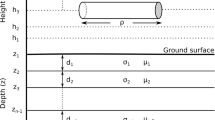Abstract
Modern electromagnetic studies of the Earth deal with three-dimensional data sets and their inversion in the class of three-dimensional models. Due to the large scale of the 3D inverse problem, it is usually solved using gradient-type iteration techniques. These techniques require repeated calculations of the gradient of the penalty function (i.e., the sum of the misfit and the regularization term) with respect to the model parameters that describe the spatial distribution of conductivity. Since there are generally no analytical tools for calculating the misfit gradient, its computation requires the application of some numerical techniques. Unfortunately, it is impossible to perform mass calculations of the misfit gradient even using modern computing if one applies conventional numerical differentiation. In reality, in this case the number of calls of the forward problem is proportional to the number of the sought parameters, which is very large in case of a 3D inversion. However, there is a much more efficient method for calculation of the misfit gradient, namely, the adjoint-field technique. At present, this technique is widely used in the numerical schemes of the 3D inversion of electromagnetic and other data. With this technique we can calculate the misfit gradient with the same computational burden as that required for the solution of a single additional forward problem. Although this technique is widely used, we failed to find any comprehensive description of this technique in the literature that would allow one to apply this approach for any particular scheme of sounding, profiling, or transillumination as easily as a general formula is applied for a given case. In the present paper, we obtain general formulas for the quick calculation of the derivatives of the frequency-domain responses and the derivatives of the misfit function with respect to the variations in conductivity. We also show how the derived general formulas are transformed into particular expressions when we consider the response functions of the conventional and generalized magnetotelluric methods. In addition, we demonstrate how to apply our general methodology to the inversion of magnetovariational induction vectors (tippers), the phase tensor, and multipoint transfer functions, namely, the horizontal magnetic and telluric tensors.
Similar content being viewed by others
References
D. B. Avdeev and A. D. Avdeeva, “3D Magnetotelluric Inversion Using a Limited-Memory Quasi-Newton Optimization,” Geophys. 74, 45–57 (2009).
T. G. Caldwell, H. M. Bibby, and C. Brown, “The Magnetotelluric Phase Tensor,” Geophys. J. Int. 158, 457–469 (2004).
V. I. Dmitriev and M. N. Berdichevskii, “A Generalized Impedance Model,” Fizika Zemli, No. 10, 106–112 (2002) [Izvestia, Phys. Solid Earth 38 (10), 897–904 (2002)].
O. Dorn, H. Bertete-Aquirre, J. G. Berryman, and G. C. Papanicolaou, “A Nonlinear Inversion Method for 3-D Electromagnetic Imaging Using Adjoint Fields,” Inverse Probl. 15, 1523–1558 (1999).
E. Haber, “Quasi-Newton Methods for Large-Scale Electromagnetic Inverse Problems,” Inverse Probl. 21, 305–323 (2005).
E. Haber, D. Oldenburg, and R. Shekhtman, “Inversion of 3D Time Domain Electromagnetic Data,” Geophys. J. Int. 171, 550–564 (2007).
G. R. Jiracek, “Near-Surface and Topographic Distortions in Electromagnetic Induction,” Surv. Geophys. 11, 163–203 (1990).
A. Kelbert, G. Egbert, and A. Schultz, “Non-Linear Conjugate Gradient Inversion for Global EM Induction: Resolution Studies,” Geophys. J. Int. 173, 365–381 (2008).
Py. Koyama, “Possibility of Three-Dimensional Magnetotelluric (MT) Inversion by Using MT Phase Tensor data,” in Proceedings of the 11th Scientific Assembly, August 23930, Sopron, Hungary, 2009.
R. L. Mackie and T. Madden, “Three-Dimensional Magnetotelluric Inversion Using Conjugate Gradients,” Geophys. J. Int. 115, 215–229 (1993).
P. R. McGillivray, D. W. Oldenburg, R. G. Ellis, and T. M. Habashy, “Calculation od Sensitivities for the Frequency-Domain Electromagnetic Problem.” Geophys. J. Int. 116, 1–4 (1994).
G. A. Newman and D. L. Alumbaugh, “Three-Dimensional Magnetotelluric Inversion Using Non-Linear Conjugate Gradients,” Geophys. J. Int. 140, 410–424 (2000).
G. A. Newman and M. Commer, “New Advances in Three-Dimensional Transient Electromagnetic Inversion,” Geophys. J. Int. 160, 5–32 (2005).
J. Nocedal and S. J. Wright, Numerical Optimization, 2nd ed. (Springer, Berlin, 2006).
L. Pellerin, J. M. Johnston, and G. W. Hohmann, “Three-Dimensional Inversion of Electromagnetic Data,” in Proceedings of the 63rd Ann. Int. Meeting SEG, London, 1993, pp. 360â ”363.
W. Rodi and R. L. Mackie, “Nonlinear Conjugate Gradients Algorithm for 2-D Magnetotelluric Inversion,” Geophys. 66, 174–187 (2000).
V. S. Vladimirov, Generalized Functions in Mathematical Physics (Nauka, Moscow, 1979) [in Russian].
M. S. Zhdanov, The Theory of Inverse Problems and Regularization in Physics (Nauchnyi Mir, Moscow, 2007) [in Russian].
Author information
Authors and Affiliations
Additional information
Original Russian Text © O.V. Pankratov, A.V. Kuvshinov, 2010, published in Fizika Zemli, 2010, No. 9, pp. 63–80.
An erratum to this article can be found at http://dx.doi.org/10.1134/S1069351310110108
Rights and permissions
About this article
Cite this article
Pankratov, O.V., Kuvshinov, A.V. Fast calculation of the sensitivity matrix for responses to the Earth’s conductivity: General strategy and examples. Izv., Phys. Solid Earth 46, 788–804 (2010). https://doi.org/10.1134/S1069351310090089
Published:
Issue Date:
DOI: https://doi.org/10.1134/S1069351310090089



